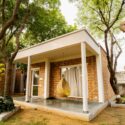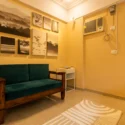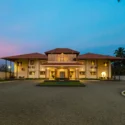Insights into the role of environment and comfort in recovery
Our weekly webinars talk about various industry scenarios and challenges of rehabs across the country and the de-addiction and mental health challenges the mental health community faces and people in general.
In the third webinar of a new 2021 series, we invited Ms Shraddha Banerjee – Clinical Psychologist and Dr Anant Agrawal – Psychiatrist at Safehouse Wellness Retreat, Delhi. The webinar was hosted by Ms Akansha – Assistant Project Manager of RehabPath, India, who was assisted by Ms Rajnandini – Editor of RehabPath, India and professional psychologist.
In this webinar, Dr Anant Agarwal and Ms Shraddha Banerjee gave insights into the role of environment and comfort in recovery from alcohol and drug addiction.
You can read the summary of the webinar below or you can watch it online here.
Rajnandini: Please tell us about you and Safehouse Wellness Retreat.
Dr Agarwal: I am a consultant psychiatrist with over 6 years of experience in the mental health industry and over a decade in the medical industry. I have been with Safehouse for over a year now. I majorly practice de-addiction but also take patients with mental health issues.
Ms Banerjee: I am RCI registered clinical psychologist, practising in Delhi for a decade now. I have been associated with Safehouse since 2015. Apart from substance use, I also work on relationship therapy, adolescence and marital issues, mood disorders and similar areas.
Safehouse Wellness Retreat is located in Delhi and offers luxury rehab facilities to its patients. We mostly believe in individual treatment sessions, therefore do not have many patients at the same time in the centre. We only take voluntary admissions in the Safehouse.
We mainly practice three types of treatment modalities here – psychiatric modality, clinical psychology, and AA, NA, 12-step program. We do not impose any of the modalities on our clients.
We ask the clients to participate in all of the modalities from where they can choose whichever they like. Sometimes, it has been seen that people are doing good in their recovery but they do not relate to the AA, NA, or 12-Step program. We give our clients the freedom to choose their preferred treatment method.
We believe that all the modalities play their part in the recovery process. And with that belief, we cordially practice our treatments here at the Safehouse Retreat Centre.
One more aspect that makes us unique is the skill development practices being followed during the treatment process. We encourage all our clients to put forward their specific needs or requests for us to consider if it improves their overall recovery.
Rajnandini: What is the role of the environment in our recovery?
Ms Banerjee: Not only for substance abuse, but the environment also plays a crucial role in mental health recovery as well. Like any other chronic disease where we try to make the client comfortable, we believe the same should happen for mental health problems.
We have seen that confined environments make patients rebellious. The deficits in the environment make recovery difficult. Internal developments are important to accelerate acceptance, which is the first step to recovery.
If the patient is preoccupied with environmental deficits, it will hamper their recovery process. Environment plays an essential role in recovery and here at Safehouse, we provide almost all kinds of luxury facilities for our clients that help them recover better.
The patients even visit us for follow-ups themselves since there is no pressure of any kind whatsoever. Our patients have freedom and stay in peace inside the Safehouse.
Rajnandini: You talked about the confinement of space that brings out the rebellious nature of the patients. Could you please tell us more about other environmental stressors that hinder the recovery process?
Dr Agarwal: As we talked about the confined space, this particular aspect in terms of treatment modalities are being studied for a long time now and has majorly increased in the last few years. The world is trying to figure out whether the environment anyhow contributed to the patient outcome or satisfaction.
Many studies have been done in various countries that have clarified these factors. Like Ms Shraddha said that the environment does have a significant role to play, stressors have also been identified at many places particularly in hospital environments or stressful events.
There have been four types of stressor classifications. The first environmental stressor is cataclysmic events (or catastrophic) like earthquakes, fire, and similar, to which we do not concern ourselves. The remaining three are of high importance.
These are stressful life events, daily hassles, and ambient stressors.
When we talk about stressful life events, we talk about a day in the life of a person with an addiction. For them, each day starts and ends with stressful life events after consuming the substance. A person suffering from substance dependence suffers from stressful events significantly throughout their routine days.
The next is daily hassles, which includes internal conflicts like what to do in a day and the person is uncomfortable in leading the daily life.
Last is ambient stressors. Multiple studies have been carried out on ambient stressors like noise, confined space, and pollution. Most of the studies have declared that ambient stress is one of the major causes of distress in patients of substance abuse.
In daily life, if we are working somewhere and there is background noise like a fan or AC, it disturbs all of us. However, we do not attend to these details at home or if we have done that, we have become habitual to it. In rehab, the patients come when they are already going through a lot of stress and want a peaceful environment.
When these ambient stressors are present, every little disturbance makes it more stressful. So the purpose of providing a luxury rehab and comfortable environment is to remove these stressors or minimise them as much as you can.
As Ms Banerjee said, Safehouse is a farmhouse away from the city bustle and pollution. The studies done in general hospitals in the US have shown that if parameters like sleep, pain, and stress are addressed, the recovery process accelerates. Safehouse has been designed to look like a home. We try to provide a home-like environment to our patients during the treatment process as well.
Rajnandini: I have realised when it’s raining or gloomy, it affects your productivity. I would like to know what the environment of Safehouse looks like and how it helps them recover?
Ms Banerjee: Safehouse is close to nature away from the city where the patients can carry out their activities comfortably. Safehouse has luxury amenities like comfortable rooms with king-size beds, a private balcony, and a jacuzzi. We also have swimming pools, a multi-equipped gym, laundry, and firesticks.
These are the facilities our clients enjoy when there are no sessions. The room service is also available but we do have a big dining space. These are some of the many luxury services we provide to make our client’s recovery process a little pleasurable.
We as professionals have other aspects to take care of like how to modify their personality or bring cognitive change. There are multiple opportunities for us to explore because of environmental factors. It further helps in increasing the contribution
Rajnandini: It does sound like a comfortable environment that helps in reducing stressors. In terms of the speed of recovery, how much does comfort matter?
Ms Banerjee: There is no doubt that comfort accelerates recovery. If I am in a comfortable environment where I can focus, it’ll help me recover better. It also induces lifestyle or psychological changes upon which we significantly focus.
We also have a good follow-up rate that is only increasing. The environment of Safehouse is also helping the patients in novelty-seeking behaviour. As I said there is a multitude of activities, our clients can stay engaged and break the monotony.
Boredom is an important reason to relapse. It is a hindrance to the recovery process. They can practice modification of their ways of life rather than complaining about how to stay occupied.
Dr Agarwal: You can now understand that recovery is a lifetime process and does not happen only when you are in rehab. I think it is a journey that happens over a period after you have left the rehab centre. It is another thing when you stay in the comfortable environment of rehabs. You would want to come back for the follow-up sessions. I have seen in many centres that the follow-up rate is poor because the patients rarely want to come back because of the comfort levels.
Now that they have an idea of what comfort looks like at Safehouse, our clients like coming back for follow-ups and discussions, which is equally important for recovery.
Rajnandini: It does sound like having something to look forward to and enjoy the recovery process. Nutrition is equally important for recovery. So, what do you think is the role of nutrition or diet in withdrawal management?
Dr Agarwal: Many of us neglect the value of proper nutrition. We usually focus on the treatment modalities and staying away from the substance, while neglecting the holistic approach. We require food to maintain our bodily functions. When you are in an unhealthy mental and physical state, nutrition becomes important as you may have multiple deficiencies because of substance abuse. Many patients also end up with chronic illnesses like hypertension and diabetes because of substance use.
All these aspects require specific nutritional modifications that we add to our patient’s meals. As an aftermath of the substance abuse, their appetite is automatically reduced. We try to regulate their diet and nutrition by discussing their requirements. As we said, Safehouse has a chef who tries to cater to everyone’s needs. The next day’s menu is decided either by us, the patients, or both of us.
This is overlooked often. When a patient enters rehab, they do not have much idea of the dietary requirements their body needs. So, we sit with them to work on their dietary modifications.
Ms Banerjee: As Dr Agarwal said, many patients come with medical conditions like liver sclerosis or pancreatic disease. In such cases, gastroenterologists also give dietary instructions. Even though our chef is aware of all such parameters, we do have nutritionists on board to help us through it. There is a focus on liquid diets as well. Food can be customised as per dietary requirements.
Rajnandini: How is anonymity maintained in Safehouse, especially for high profile clients?
Ms Banerjee: We have come across some clients who demand total confidentiality and may or may not book the entire place for themselves. Some ask us not to mention their name on the file as well. In the past, we have had celebrities and politicians stay at our place under complete anonymity. We respect that and follow whatever is required to do that.
Dr Agarwal: Sometimes patients also demand not to go for group sessions, which is essential for maintaining anonymity. We try to cater to their individual needs as well. We take their sessions in private rooms or their rooms for the same reason.
Rajnandini: How should one choose the right rehab for themselves?
Dr Agarwal: There are a few factors that one must consider before deciding on the type of rehab. The first is treatment modalities. The quality of a treatment given at rehab is of utmost importance, making luxury and comfort secondary. The right rehab will be different for different people. You have to see what suits you – whether you want to go for psychiatric treatment, psychological aspects, or a 12-Step program.
Let us say you are visiting rehab for the first time. I would suggest you choose the one that has a range of treatment modalities and other services. For instance, major treatment modalities followed in various rehabs are psychiatric, psychological, and 12-Step Program. Apart from this, many centres also offer yoga and meditation-based treatment modalities. Try to find a place where most of these are clubbed together so that you can choose your best-suited treatment modality.
The next factor is the comfort level. You must see whether you can focus on the treatment during your stay or should you need a change. Let us say, you have all the modalities but your movement is confined to a place. You are forced to attend different sessions or listen to their listed services. It would be detrimental to the entire treatment process. So, people must consider if that environment is comfortable enough for them to recover. Since you may have to stay in the rehab for more than a month, comfort becomes of utmost importance.
The next factor is recreational activities. You won’t be engaged with the session throughout your day, therefore recreational activities become important for relaxing. You need to have something you build for you to take it home and incorporate into your lifestyle.
When a person goes back home, they do not have regular psychotherapies or similar sessions, they must build their habits while staying at the rehab that will help them after leaving the rehab. Any place that provides multiple recreational activities would be the next factor to consider for rehab.
The last factor as per my knowledge is food and safety. The nutritional program your rehab follows is equally important as the treatment. Safety for me is that you are surrounded by like-minded people and there is less conflict between patients.
These are all the factors you must consider.
Rajnandini: What are the elements of a basic treatment plan?
Dr Agarwal: When it comes to nutrition, we initially offer our patients our fixed diet plan. After that, we try to cater to their individual needs. Whenever we do an assessment, we try analysing the triggers of addiction to have customised treatment plans for all our patients.
Our basic treatment plan has five major elements:
- Psychiatric assessment and treatment – includes detox and withdrawal management with medicines
- Understanding biological mechanism of addiction and psychological evaluation – identifying triggers of substance abuse, cognition, and similar aspects
- 12-Step Program – includes AA, NA
- Yoga and meditation
- Lifestyle modifications – includes diet and recreation
The daily schedule is also tailored to meet individual requirements.
Rajnandini: What is your take on the 12-Step Program? Have you ever modified it?
Dr Agarwal:
Ms Banerjee: The 12-Step Program is popular and without it, we cannot fully recover. Though certain points under AA are still debatable, like one must reach the rock-bottom for recovery. As a professional, I can’t discard any of these. Some helpful concepts like building the acceptance of powerlessness, working on your resentment, I incorporate points in CBT (Cognitive Behaviour Therapy).
What AA focuses on is similar to CBT sessions like changing their behaviour or addressing cognition issues. We try to incorporate all the points that are helpful as per me and my colleagues.
Rajnandini: Please tell us what your clients usually like about their stay at the Safehouse Retreat.
Dr Agarwal: We usually cater to all individual needs but some things remain fixed that are essential for a better routine. Normally, when the patient’s wake up, they are expected to work out, followed by breakfast (before 10 AM). It is then followed by AA sessions (10 AM to 1 PM) for which the counsellor usually stays at the facility. All sessions can be of an individual or group category depending upon the client’s requirement.
Then, the clients have sessions with me and Ms Shraddha for biological and psychological assessment. We have lunch from 2 to 3 PM. Many clients also try to squeeze in some recreational activity in between like a game of pool, table tennis, or swimming. During the evenings (around 5 PM), our entire staff loves to play cricket for which they form teams with the patients.
By the time the game finishes, the patients need to go for their yoga sessions. We usually give our patients the time to relax after this. Our patients can also choose to interact with each other, play some games, or sit and relax. This is a usual day at Safehouse Retreat.
I believe our patients like autonomy during the entire treatment process. Our patients have autonomy over choosing their treatment plans, diets, or daily schedules. Another most appreciated thing is they are allowed to keep their gadgets like phone and laptop in case they are working or don’t want their business to suffer.
Our patients include businesspersons, politicians, and celebrities. Such people can work during their stay at Safehouse.
Ms Banerjee: When the clients admit themselves at the centre, we prepare an activity schedule by thoroughly considering our client’s requirements. We ask about their interests, likes and dislikes. Some patients are morning people. They may get up early in the morning and want coffee for which we have provided a coffee maker in each room.
We do have a fixed period for breakfast, lunch, and dinner that our patients have to follow. However, we try to incorporate their needs in between sessions and fixed periods.
Besides, we organise small gatherings for our patients like barbeque by poolside or dance sessions wherein our staff also participates. Our clients also like this freedom of doing these things.
Since there is a correlation between substance and pleasure, we incorporate the change required in the daily habits of our patients. We make use of our wonderful chef by organising a tea party for our patients who have completed 90 days or a good dinner with music.
Rajnandini: The pandemic changed almost everything. How have you extended your care and services towards your clients and patients?
Dr Agarwal: Like any other time, our services have continued similarly. But it was the time we saw a rise of mental illness in people wherein we observed an increased inflow of our patients. There was a fear of contracting the infection.
We tried making our services such that we deal with the pandemic along with their mental health challenges. We shifted our services online, including follow-ups. It was challenging at the beginning, we and our patients gradually got the hang of it.
For the inpatient facility, we had a mandatory negative RT PCR test for COVID. We also restricted the entry of outside people to ensure safety of our staff and patients. We also conducted online family therapy sessions as no one was allowed on the campus from outside. There was also a time when even Ms Banerjee and I stayed at the facility to avoid being the carrier of COVID-19.
We stayed at the facility to prevent getting exposed to the virus. Even after taking these measures, one time a patient tested positive for COVID-19. We isolated the patient after 10 days when they started showing symptoms even after a negative RT PCR test. Since it was the peak of infection, our patient was fearful of being discharged and going back home or to the hospital.
We coordinated with the government authorities and facilities to keep the patient isolated at our centre under constant observation. The patient recovered both from COVID-19 and substance use in a month of their stay at Safehouse. We took this case as a challenge and decided to help when our patient needed it the most.
Rajnandini (Question from participant): What is the treatment range at Safehouse? If the patient is critical, can a family member stay with them at Safehouse?
Ms Banerjee: For chronic cases, we allow one family member to stay with the patient. We have shared and individual rooms at Safehouse. Family members can stay with the patients in individual rooms. We also have a physician on-site who can advise the family members for a second opinion or during emergencies.
Dr Agarwal: We also allow family members to stay with the patient for a week or so if they demand.
Rajnandini (Question from participant): How do you deal with the extreme cases of addiction or mental health issues? Do you administer any sedatives on them?
Dr Agarwal: As we mentioned earlier, Safehouse is a completely voluntary centre. When the patients are intoxicated, we rather opt for counselling at first than administering sedatives. We only advise medicines to manage the withdrawals. Besides, we do not take involuntary admissions.
Rajnandini (Question from participant): Do you have any tips for international patients considering Safehouse right now?
Ms Banerjee: As I said, Safehouse has the most comfortable environment and treatment process. People can find for themselves with whom they would like to continue. Willing to take the treatment is the first step. Our treatment teams work cordially and prefer prioritising the client.
We do have an official number and other information on our website from where people can reach us and take the steps forwards to recovery. You can also email us at [email protected]. We also organise virtual tours or video interactions with both of us for them to have a basic understanding of our different processes.
Rajnandini (Question from participant): What is your success or relapse rate at Safehouse Retreat?
Dr Agarwal: If we talk about follow-up rates regarding relapse, We have a 90% success rate of which 70% have been in successful abstinence. Recovery is a long process. It is only based on the people who take regular follow-ups after leaving the centre.
Rajnandini: You talked about voluntary admissions. Do you come across any involuntary cases wherein the family visited Safehouse with the patient?
Dr Agarwal: We usually do not take involuntary admissions. We advise them to try to make the patient understand the treatment process or consider family therapy sessions. We also try to make the family aware of everything going on with the patient and how to proceed to make it easier for the patient. We also encourage the family to bring the patients for OPD sessions for them to see the environment and comfort levels. It has usually been motivational enough for patients to volunteer.
Ms Banerjee: There is a stigma surrounding rehab centres in our society. It is one of the main reasons that pull patients from admitting themselves to a rehab centre. We had a similar case wherein the patient and family visited us for more than a month before finally deciding to take admission at the facility.
We give time to our patients to understand and get comfortable with our processes before finalising anything. If they make voluntary decisions, the outcome is positive.
Rajnandini (Question from participant): Are you planning to expand, especially in South India?
Dr Agarwal: The biggest challenge is tackling comorbid conditions with substance use. It is problematic because the family members generally expect a lot from a rehab centre, especially treatment modalities. There have been times when the patient’s blood sugar levels have fluctuated or other things have happened. These are some major challenges we face. We have to be careful about monitoring such patients and conditions.
Although, we do consider basic assessment from our in-house physician first that is beneficial for the patients to start an adequate treatment process.
Akansha: Thank you for giving us an informative session. Before concluding, would you like to give us any message?
Dr Agarwal: We sometimes start seeing substance use as a social or moral problem. It has created the biggest stigma in our society for people to address and treat. When we start seeing something as a social or moral construct, we fail to understand addiction as an illness. We all must know that substance abuse and dependence are illnesses that can be treated through appropriate treatments.
If you have any other substance abuse problems, get help as fast as you can. Go to your nearest psychiatrist or a rehab centre and get the help you need. All the rehabilitation centres are open.
For more webinars like this, follow us on Facebook.













